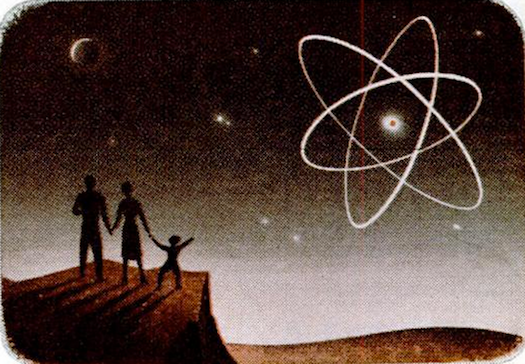Click here to enter the gallery
When Popular Science published these dazzling visions of the future in May 1947, science seemed to be propelling humanity faster and faster into a strange new world: engineers and pilots were making the first flights to graze the edges of space; physicists had already unleashed the horrifying power of the atom bomb; and governments were funding audacious ideas like weather control.
In the cover story “Science Never Stops,” writer Harland Manchester described science as a “blank check”: “The world has made vast strides in the last 75 years; even greater triumphs lie ahead if mankind has the courage to go on with the job,” he wrote.
While some of the ideas in this article didn’t quite come to pass (we haven’t yet established a global communications system using moon microwaves) others were more prescient: many major cities now have beltways, and humans have indeed traveled to the moon and back—and we may be on our way to Mars. See the gallery for a look at what the big dreamers of 1947 thought the future would be like.
Space Travel
“The man of 40 will live to by flabbergasted by new strides in transportation. Before long, robot planes with recording instruments will probably penetrate the transonic speed barrier, that mysterious region lying between 640 and 950 m.p.h. The future of really fast travel lies in the waste spaces of the heavens. A V-2 rocket has already been sent up 114 miles … Restless man will probably throw himself at the moon, at Mars, and at other chunks of matter and return to write books about it.” Read the full story in the May 1947 issue of Popular Science.
Beltways Around Cities
“If we select a number of ideas that have been proposed by advanced architects and planners, the city of the future may look like this: It will be surrounded by a multilevel belt highway near which industry will be relocated to isolate much heavy traffic. Within this great circle, the city is divided into self-contained sections, each circled by a one-way ‘ring street’ to prevent through traffic and to restore to residential streets the character of additional ‘living space’ that they had in the horse-and-buggy days… all incoming private cars, with few exceptions, would park in lots provided at the city limits, where the occupants would receive free bus tickets to the center of the city.” Read the full story in the May 1947 issue of Popular Science.
Weather Control
“Meteorologists would aid in city planning, breaking up streets to check cold winds. Walls of city gardens and courtyards and walls lining streets would have large louvres, like outdoor Venetian blinds, set to catch the sun’s heat rays in summer and bounce them back into the sky. Better still, snowstorms over cities may be prevented by sending planes to ‘seed’ the clouds with dry-ice pellets, making them dump their cargo in the country.” Read the full story in the May 1947 issue of Popular Science.
Harnessing Photosynthesis
“Perhaps the most ambitious goal of science is the duplication of the process of photosynthesis, by which plants, with the catalytic aid of their green chlorophyll, utilize the sun’s energy in the production of sugar, starch, proteins, fats and cellulose—without which life on earth would end. If the efforts of brilliant research men should bear fruit, there might ensue a golden age of plenty for all mankind.” Read the full story in the May 1947 issue of Popular Science.
Moon Microwaves
“Microwave relay networks will cover the country, using wave lengths a few inches long to carry all oral and visual intelligence, including FM broadcasting, phone calls, telegrams, and facsimile. By means of such a coordinated system, a general in the Pentagon could throw on his office screen radar scopes in any part of the country and see what planes are in the air, and the telephone band could be so wide that every house in a city of 10,000 could have its own radiophone wave length. The networks may be extended throughout the world by putting relay station in planes that spell one another in the stratosphere, or by bouncing the microwaves off the moon.” Read the full story in the May 1947 issue of Popular Science.
Uranium Batteries
“If we persist in harnessing the atom to our present engines, we will copy the early motorcar makers who mounted gasoline engines in buggies. A great goal seen by scientists is the direct conversion of atomic energy into electric power without routing it through the cumbersome heat cycle. How about some method of inserting metal terminals in a uranium pile and drawing electric power as you would from a battery?” Read the full story in the May 1947 issue of Popular Science.
The Future
“Today, scores of eminent scientists, horrified at the killing power of the splitting atom, are earnestly working to unite all peoples in a master plan to harness it in the service of life. We’d better help them, and do it fast. Once we have jailed this blood-thirsty outlaw, the same plan can be used to control other scourges, both man-made and natural. Man will then have a chance to fulfill his destiny through science.” Read the full story in the May 1947 issue of Popular Science.







